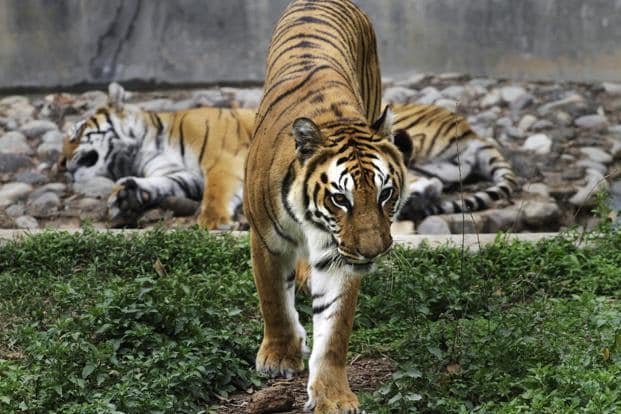
Why in News?
Nepal’s Prime Minister, KP Sharma Oli, has proposed a controversial idea of using excess tigers as “gifts” for economic diplomacy. The proposal comes amidst Nepal’s remarkable tiger conservation success, but also highlights challenges like human-wildlife conflict and poaching. This suggestion has reignited debates on the ethics of keeping tigers as diplomatic tokens and pets.
Introduction
Nepal has emerged as a global model for tiger conservation, achieving a 296% increase in tiger population in just over a decade. From 120 tigers in 2009 to 355 in 2022, Nepal’s efforts have been lauded worldwide. However, this success story comes with challenges, including rising cases of human-wildlife conflict and poaching. Against this backdrop, PM Oli’s suggestion to use excess tigers as gifts recalls Nepal’s history of “shikar diplomacy” and raises ethical and practical concerns about wildlife conservation.
Key Highlights
Nepal’s Tiger Conservation Success
Tiger Population Growth:
- In 2009: Nepal had only 120 tigers.
- By 2022: The number increased to 355, representing a 296% rise.
- Recognized globally as a conservation success story.
Challenges:
- Human-Wildlife Conflicts: Between 2019 and 2023, nearly 40 human deaths and 15 injuries were reported due to tiger encounters.
- Poaching and Illegal Activities: Rising tiger population has also led to increased poaching risks.
PM Oli’s Proposal
Using Tigers as Diplomatic Gifts:
- At a COP29 review event, PM Oli suggested gifting “excess” tigers to other countries as a form of economic diplomacy.
- Justified this idea by comparing tigers to other animals kept as pets, such as falcons and peacocks.
Rationale:
- Address the rising population of tigers in Nepal.
- Leverage tigers as assets in fostering international relations.
Historical Context: Shikar Diplomacy
Rana Era (1846–1951):
- Nepal’s rulers facilitated tiger hunting expeditions for British nobility.
- Tigers were gifted as symbols of goodwill to nations like Britain, France, Germany, Austria, Japan, and China.
Diplomatic Role:
- Tigers played a significant part in building international alliances.
- Highlighted Nepal’s strong ties with British nobility during the colonial period.
Tigers as Pets and Status Symbols
Captivity Statistics:
- According to the WWF (2021), around 5,000 tigers live in captivity in the U.S., exceeding the 3,900 wild tigers globally.
- Big Cat Public Safety Act (2023): The U.S. banned private ownership of big cats to curb animal cruelty.
Global Trends:
- Pakistan’s Punjab Province: Recently passed a law allowing individuals to keep big cats as pets by paying a fee.
Ethical Concerns:
- Tigers are apex predators with complex needs that cannot be met in captivity.
- Captive tigers often face poor living conditions, inadequate health care, and abnormal behaviors.
Key Terms and Definitions
Tiger Conservation:
- Efforts to protect and increase the tiger population through habitat preservation, anti-poaching measures, and community engagement.
Apex Predator:
- A predator at the top of the food chain with no natural predators of its own (e.g., tigers).
Shikar Diplomacy:
- The historical practice of gifting tigers and hosting hunting expeditions to foster diplomatic relations.
Big Cat Public Safety Act:
- A U.S. law passed in 2023 prohibiting the private ownership of big cats to prevent animal cruelty.
COP29:
- The 29th annual Conference of the Parties under the United Nations Framework Convention on Climate Change (UNFCCC), focusing on climate action and conservation.
Challenges of Using Tigers as Diplomatic Gifts
Conservation Concerns:
- Moving tigers to new environments may disrupt their well-being and adaptation.
- Risk of exploitation as mere status symbols.
Ethical Issues:
- Tigers are wild animals, not commodities for diplomacy.
- Keeping tigers as pets often leads to poor welfare conditions.
Practical Challenges:
- Transporting and maintaining tigers require extensive resources and expertise.
- Potential for misuse in countries lacking robust wildlife laws.
Human-Wildlife Conflict:
- While addressing excess tiger populations, the root causes of human-tiger conflicts—habitat encroachment and poaching—must be tackled.
Recommendations for Sustainable Tiger Conservation
Transboundary Cooperation:
- Collaborate with neighboring countries for shared tiger habitats.
- Establish tiger corridors to reduce population pressure in specific areas.
Strengthening Anti-Poaching Measures:
- Increase funding and technology for surveillance in protected areas.
Community Engagement:
- Incentivize local communities to participate in conservation efforts.
- Address human-wildlife conflicts through education and compensation schemes.
International Conservation Alliances:
- Work with global organizations like WWF and CITES to ensure ethical conservation practices.
Ethical Relocation:
- Explore relocating tigers to other habitats within the country or to ethical sanctuaries abroad.
Conclusion
Nepal’s success in tiger conservation is a testament to effective wildlife management, but the rising tiger population presents complex challenges. PM Oli’s proposal to use tigers as diplomatic gifts has historical precedence but raises ethical, ecological, and practical concerns. Rather than resorting to gifting tigers, Nepal should prioritize sustainable and humane solutions to address population pressure. The proposal serves as a reminder of the delicate balance required in conservation policies, emphasizing the need for global cooperation and ethical practices.




